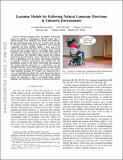Learning models for following natural language directions in unknown environments
Author(s)
Duvallet, Felix; Howard, Thomas M.; Stentz, Anthony; Walter, Matthew R.; Hemachandra, Sachithra Madhawa; Roy, Nicholas; ... Show more Show less
DownloadRoy_Learning models.pdf (2.975Mb)
OPEN_ACCESS_POLICY
Open Access Policy
Creative Commons Attribution-Noncommercial-Share Alike
Terms of use
Metadata
Show full item recordAbstract
Natural language offers an intuitive and flexible means for humans to communicate with the robots that we will increasingly work alongside in our homes and workplaces. Recent advancements have given rise to robots that are able to interpret natural language manipulation and navigation
commands, but these methods require a prior map of the robot’s environment. In this paper, we propose a novel learning framework that enables robots to successfully follow natural language route directions without any previous knowledge of the environment. The algorithm utilizes spatial and semantic information that the human conveys through the command to learn a distribution over the metric and semantic properties
of spatially extended environments. Our method uses this distribution in place of the latent world model and interprets the natural language instruction as a distribution over the intended behavior. A novel belief space planner reasons directly over the map and behavior distributions to solve for a policy using imitation learning. We evaluate our framework on a voice-commandable wheelchair. The results demonstrate that by learning and performing inference over a latent environment model, the algorithm is able to successfully follow natural language route directions within novel, extended environments
Date issued
2015-07Department
Massachusetts Institute of Technology. Computer Science and Artificial Intelligence Laboratory; Massachusetts Institute of Technology. Department of Aeronautics and AstronauticsJournal
Proceedings of the 2015 IEEE International Conference on Robotics and Automation (ICRA)
Publisher
Institute of Electrical and Electronics Engineers (IEEE)
Citation
Hemachandra, Sachithra et al. “Learning Models for Following Natural Language Directions in Unknown Environments.” 2015 IEEE International Conference on Robotics and Automation (ICRA), 26-30 May, 2015, Seattle WA, USA, IEEE, 2015. 5608–5615.
Version: Original manuscript
ISBN
978-1-4799-6923-4